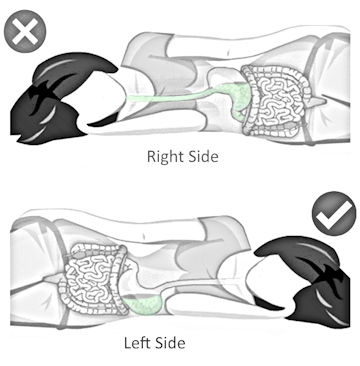My Experience With Elevating The Bed For GERD Relief
To be perfectly transparent with you, when I was first told that elevating my upper body in bed would help control my GERD, I thought it was a load of hooey. I was a stomach sleeper at the time, and I rarely even used a pillow. Completely changing everything about how I slept was not on my to-do list, nor did I want it to be. I was pretty stubborn, and, let’s face it, pretty dumb at this point. It took waking up with relatively painful reflux every day for several months to change my mind.
As it turns out, there’s actually some truth — some science — behind sleeping recommendations. Who knew?! (Okay, a lot of people knew, but I was finally catching up.) Because I’m a huge fan of science, I decided to dive wholeheartedly down the reflux/sleep rabbit-hole. One of the first things I learned was that the physical orientation of your digestive system when you’re lying down can affect things like acid reflux, gas, and possibly even symptoms of inflammatory bowel diseases (like Crohn’s). The diagram below shows why side-sleeping matters.
When you lie on your left side, gravity helps keep the stomach contents in the stomach. If there’s reflux into the esophagus, gravity is going to more quickly help get those contents back into the stomach where they belong.
The Perfect Angle…FOR GERD RELIEF
In addition to left-side sleeping, I also learned that most sleep medicine and GI guidelines recommend 6-8 inches (15-20 cm) of elevation at the head of the bed. This works out to approximately a 15-20 degree incline. Why not higher? More than ~30 degrees of incline can cause sliding down the bed, or put undue strain on the lower back and/or hips.
Don’t be like me and assume that sticking a couple of firm pillows under your head will do the trick. Doing that tends to kink the neck and doesn’t really keep the esophagus horizontal. You’ll end up with a very sore neck AND reflux. The point of the exercise is chest-up elevation.
MISTAKES WERE MADE…IN THE NAME OF GERD RELIEF
It doesn’t have to cost a lot in order to achieve the optimal sleeping posture. Let me repeat myself: It doesn’t have to cost a lot in order to achieve the optimal sleeping posture. I said it twice so you won’t do what I did and spend $5000 on a Tempur Ergo Smart adjustable base and a Tempur-Adapt mattress. I’m not sponsored, by the way. I just really liked the bed. On top of being adjustable, it did cool things like massage, and it had neon lighting underneath.
That said, the bed was 100% unnecessary for helping control my GERD. We were in the market for a new bed, and we made a financially irresponsible purchase. We’re not the kind of people who would normally spend five grand on a bed, but we felt like we had a reason. It felt like a medical purchase.
The first week of owning that bed was fantastic. It had a remote control! We played with all the settings. Up. Down. Hey, it’s programmable! Whoa, the green light looks like radioactive waste! Ooh, massage. Did I sleep better? Wake less GERD-y? I honestly don’t remember.
By Week 2, we were over it. Raised feet were a no-go for the husband, but without the raised feet, we both slid down the bed during the night to sleep flat. The massage feature was pretty loud for apartment use. The glowing lights? Cool, but neon isn’t actually that great for sleeping.
We had that bed for two years, and beyond the first few weeks, we rarely used any of the features. If I had a do-over, I’d have bought a different bed for a fifth of the cost and taken a nice vacation with the rest.
SWEET DREAMS…AND BETTER SLEEP WITH GERD
When we moved from the US to the UK, we couldn’t take the bed with us. Shipping furniture overseas would have cost us again what we paid for the bed, and so… we gave it away. Painful decision, but unavoidable. I hope the person who took it off our hands is using its features to their fullest.
Our new bed was a thirty-year-old mattress, soon to be replaced by a “floor bed”. As it turns out, the perfect bed for my husband — and surprisingly, me — is no bed at all. Not in the traditional Western sense, anyway. As it turns out, we weren’t the only ones sleeping closer to the floor. Nor was it a particularly new idea.
In Japan, for example, traditional futons are rolled out each night on tatami mats and folded away in the morning. It’s practical for small spaces, but it also fits with a minimalist approach to life; simple, natural, and uncluttered.
In Korea, bedding is spread directly over the ondol, a heated floor that keeps homes warm in winter. The bed isn’t just for sleep; it’s part of daily life: people eat, sit, and relax on the floor together.
In northern China, the kang is a raised, heated platform that serves as both bed and living area. Families gather there to talk, share meals, and then sleep side by side.
What ties these traditions together is a sense of adaptability. Floor beds save space, keep you cooler in hot weather, or cozy (with heated floors) in cold weather. For many, they’re also believed to support posture and connect the body more closely with the natural rhythm of the home.
Today, younger Asian generations often sleep in Western-style raised beds, but floor sleeping remains. It speaks to a way of life that values simplicity, community, and being grounded in every sense of the word.
I found it to be an accidental aid for my reflux.
FLOOR BED FTW…WHY IT HELPS MY GERD
Our current floor bed is pretty simple. It’s six inches of foam padding with a covering over top, topped with two thick duvets. On my side of the bed, I have a wedge pillow for my head, a leg rest, and a cervical neck roll. I use the wedge pillow every night, with a thinner, “regular” pillow atop it. Because the entire bed rests on the floor, nothing moves, slips, or slides around. On nights when my neck hurts, I replace the “regular” pillow with my neck roll. When my legs hurt, I add the leg rest pillow; during flares, inflammation causes me leg pain.
The whole setup is inexpensive, modular, and flexibly adapts to my daily needs. Combined with left-side sleeping, I can happily report that I rarely wake feeling GERD-y. It took several years, a costly mistake, and the need to “get over myself” to succeed, but I got there.
FINAL THOUGHTS…SLEEPING BETTER WITH GERD
I know most people aren’t going to ditch their raised beds for a floor bed, and that’s okay. There are smaller steps you can try first.
Start with bed risers — they’re inexpensive (£30–50), easy to test, and often enough for mild-to-moderate GERD.
If you need more support, add a wedge pillow, neck roll, or leg rest to a conventional mattress. I’ve linked to the ones I use (not sponsored, just what actually works for me).
And if you’re ready for a bigger change, a floor bed can be surprisingly effective. Combined with left-side sleeping, it’s what finally let me wake up without feeling GERD-y.
As always, drop your questions or experiences in the comments. I’d love to hear other creative, medically sound sleep solutions. Let’s help each other feel better!

